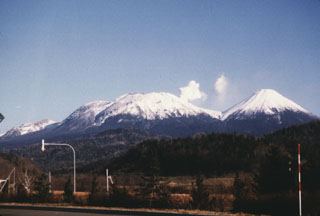Report on Akan (Japan) — October 1996
Bulletin of the Global Volcanism Network, vol. 21, no. 10 (October 1996)
Managing Editor: Richard Wunderman.
Akan (Japan) Small phreatic eruption on 21 November from a 1955 crater of Me-Akan
Please cite this report as:
Global Volcanism Program, 1996. Report on Akan (Japan) (Wunderman, R., ed.). Bulletin of the Global Volcanism Network, 21:10. Smithsonian Institution. https://doi.org/10.5479/si.GVP.BGVN199610-285070
Akan
Japan
43.384°N, 144.013°E; summit elev. 1499 m
All times are local (unless otherwise noted)
On the eve of 21 November a small phreatic eruption took place at Me-Akan. Prior to the eruption, JMA reported that volcanic earthquakes increased starting on 21 August (BGVN 21:08), decreased in the first half of September, and then increased after 28 September. Daily earthquake totals were 58 and 90 on 29 and 30 September, respectively. A total of 356 earthquakes registered during September. On 2 October 142 volcanic earthquakes took place. This sudden increase in seismicity prompted the Kushiro Local Meteorological Observatory to issue a Volcanic Advisory. Although the seismic activity began to decline on 3 October, a total of 324 earthquakes registered during October.
The 21 November eruption was initially described by Yuichi Nishimura of the Usu Volcano Observatory via an electronic mailing list about Japanese volcanism. A relatively large volcanic earthquake, sufficiently robust to saturate the seismograph, occurred at 1755 that day. After that, JMA's Kushiro station registered eight minutes of small-amplitude tremor that decreased in amplitude with time. No shock-type air waves were observed associated with the first earthquake. Intermittent small earthquakes had also been noted.
According to JMA, the total number of volcanic earthquakes on 21 November was 226, and in the morning of 22 November, 163. In contrast, in the afternoon of 22 November, there were only five earthquakes during the first three hours and none in the second three hours. Before and after the eruption tiltmeters did not show any detectable change.
Ash issued in the November 21 eruption and collected near the town of Tsubetsu (~30-40 km N) was analyzed petrographically by Tadahide Ui and his colleagues at Hokkaido University. Several days later Ui reported finding no juvenile materials, a result in accord with a visual inspection from helicopter on November 22 that suggested the eruption was phreatic and no magma reached the surface. The plume in the afternoon of 22 November was white and only 200 m high, as low as the previous day before the eruption.
On the afternoon of 22 November it was also learned that the eruption vented from the fourth crater of Ponmachineshiri, a feature that developed with three other craters during a 1955 eruption. The ash-covered area extended to the crater's N-NW and new tephra was visible 250-300 m to the S. Workers concluded that the phreatic eruption was as small as the 1988 Ponmachineshiri first-crater eruption.
Geological Summary. Akan is a 13 x 24 km caldera located immediately SW of Kussharo caldera. The elongated, irregular outline of the caldera rim reflects its incremental formation during major explosive eruptions from the early to mid-Pleistocene. Growth of four post-caldera stratovolcanoes, three at the SW end of the caldera and the other at the NE side, has restricted the size of the caldera lake. Conical Oakandake was frequently active during the Holocene. The 1-km-wide Nakamachineshiri crater of Meakandake was formed during a major pumice-and-scoria eruption about 13,500 years ago. Within the Akan volcanic complex, only the Meakandake group, east of Lake Akan, has been historically active, producing mild phreatic eruptions since the beginning of the 19th century. Meakandake is composed of nine overlapping cones. The main cone of Meakandake proper has a triple crater at its summit. Historical eruptions at Meakandake have consisted of minor phreatic explosions, but four major magmatic eruptions including pyroclastic flows have occurred during the Holocene.
Information Contacts: Volcanological Division, Japan Meteorological Agency (JMA), 1-3-4 Ote-machi, Chiyoda-ku, Tokyo 100, Japan; Tadahide Ui, Earth & Planetary Sciences, Hokkaido University, Sapporo 060, Japan.

